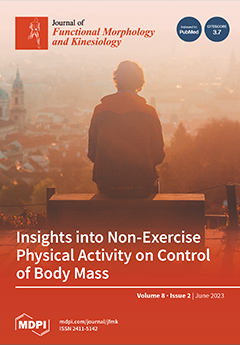The aim of the present study was to examine and compare the concentric isokinetic peak torque of the knee flexors and extensors muscles, as well as their ratio, in young soccer players. Two hundred and sixty-five (n = 265) young soccer players were divided into five groups: U-12 (n = 43, mean age 11.5 ± 0.4 yrs), U-14 (n = 63, mean age 13.6 ± 0.3 yrs), U-16 (n = 64, mean age 15.4 ± 0.5 yrs), U-18 (n = 53, mean age 17.5 ± 0.4 yrs) and U-20 (n = 42, mean age 19.3 ± 0.6 yrs). Three maximal voluntary isokinetic leg extensions and flexions at angular velocities of 60, 180, and 300°·s
−1, and H:Q strength ratio was determined. The largest H:Q strength ratio for all ages, with the exception of age group U-12, appears at a slow angular velocity of 60°·s
−1, and the smallest H:Q ratio at a fast angular velocity of 300°·s
−1. In age group U-12, at an angular velocity of 60°·s
−1, the strength of the quadriceps muscle was almost twice the strength of the hamstrings. The H:Q strength ratio was smaller in age group U-12 and greater in group U-20. In age group U-12, the greatest H:Q strength ratio appeared at an angular velocity of 180°·s
−1, while in the other age groups, it appeared at 60°·s
−1. Strength training of hamstring muscles remains inadequate across ages. The small H:Q strength ratio in younger ages and the large H:Q ratio in older ages suggest that high-intensity training may increase the H:Q strength ratio, which, in turn, may protect the knee joint from excessive and burdensome loads.
Full article






